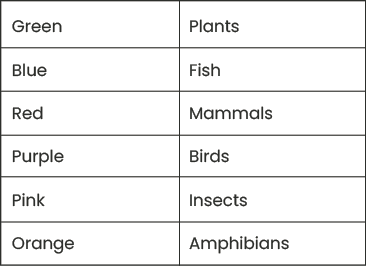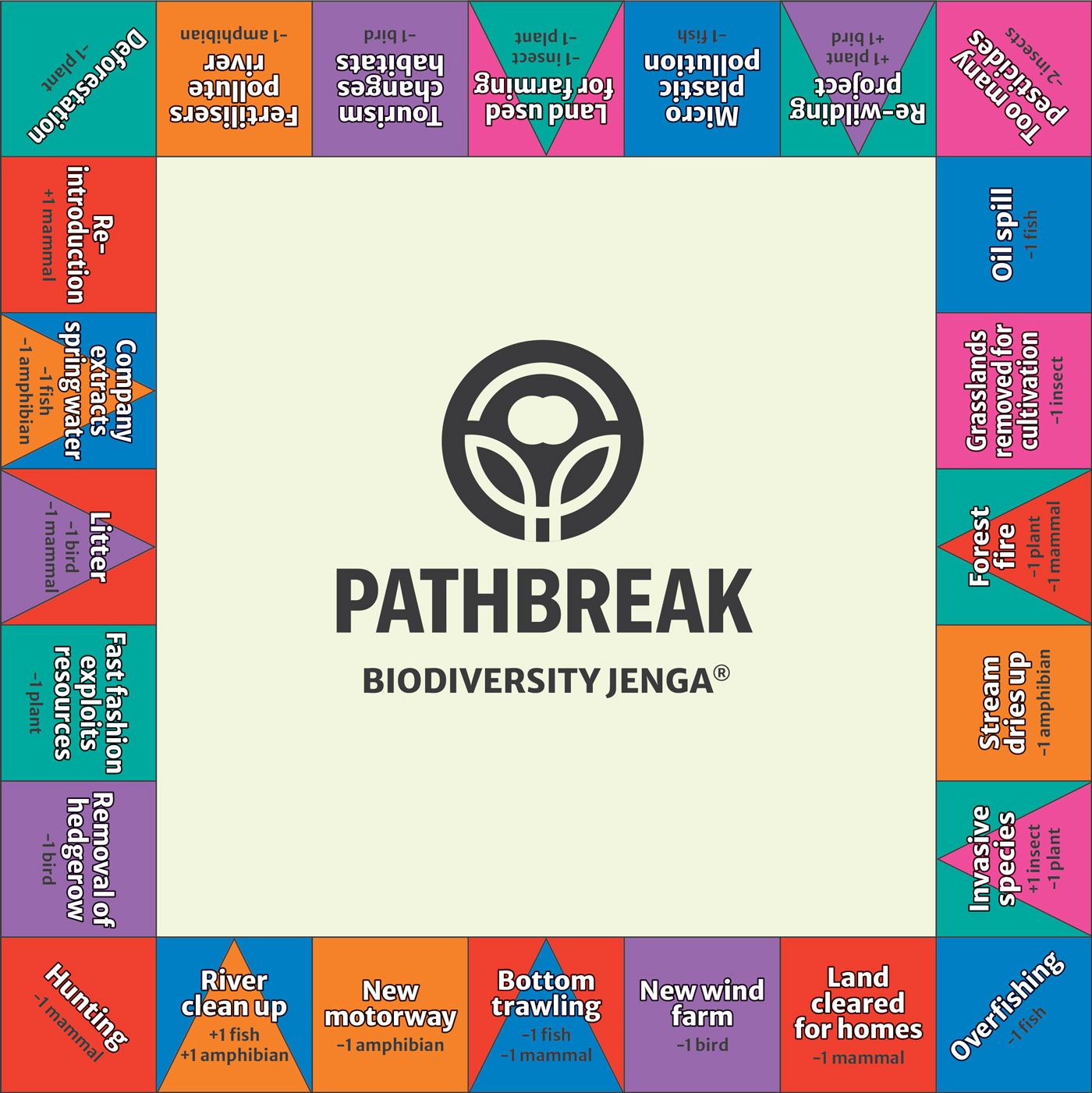Customising the Game for Your Context
The first time you play the game you will need to gather and prepare the materials, these include:
A Jenga® Game
A JENGA® game with the ends of the bricks coloured to correspond with the different species colours on the gameboard:
- A typical JENGA® set 54 bricks, there will be nine bricks of each colour
- To colour the bricks, you can use pens, paint, nail varnish, crayons, coloured stickers, etc., but make sure you only add colour to the ends as the other surfaces of the bricks are designed to slide against each other.
- The Table below explain how your colour your bricks:

The Game Board:
- A PDF printout of the board in colour can be downloaded HERE (you can also laminate it to reduce damage if the game is going to be used frequently)
- A PDF printout of a blank board which can be downloaded HERE (optional, this is to allow players to include their own rules)
- Tokens to move around the board, one per player (this can also be a coin or a similar object, or you can cut out the tokens that are printed next to the gameboard

Discussion points:
You may wish to prepare a few discussion points relevant to the group. These might relate to biodiversity, actions that connect to their local surroundings and interests, or themes that are tailored to the aims of the session.
In this video Lindy Binder explains why the design of Biodiversity JENGA® is accessible and engaging:
Game Rules & Instructions
To play the game use the following instructions:
- Set up the tower in the centre of the board by stacking wooden bricks in alternating layers of three, assemble your players around the board.
- Roll the die to decide who will begin.
- Players may start from any corner of the board.
- The first player rolls the die and moves their token the number of spaces shown, moving clockwise.
- The player follows the instruction written on the square.
For example: Forest fire – remove one plant. - The facilitator can bring the scenario to life by narrating: A forest fire has broken out, the forest is burning. With climate change and rising temperatures, these events are becoming more frequent worldwide. The fire has destroyed plants. Since plants are marked with green, remove one green brick from the tower.
- The player then takes a green brick from the tower and places it on the top.
- If a square has more than one instruction, all instructions should be carried out.
- Bricks may not be taken from the top layer of the tower unless the instruction is ‘+1 species’. In that case, a player may take one brick from the top (if available) and reposition it in a lower level where a brick has already been removed. This could steady the tower, or it could make it more unstable.
- If the instruction is to add a colour that does not appear in the top layer, the turn passes to the next player.
- If the tower collapses while a brick is being replaced, this can represent an attempt at restoration that fails. Ecosystems are complex, with countless interdependencies that are hard to predict. Even well-intentioned actions can sometimes have unexpected outcomes.
- Play continues until the tower finally falls – symbolising ecosystem collapse
In this video Lindy Binder explains how to play Biodiversity JENGA®:
Post Game Discussion
Since the activity works best as an icebreaker, the conversation afterwards is a key part of the learning process. The game itself raises awareness of the risks of biodiversity loss and provides a light introduction to complex ideas. The post-game discussion is where these themes can be unpacked, connecting the simplified model to real ecological processes and to the group’s own experiences.
Limitations of the Game
In the discussion you could acknowledge the limitations of the game as a conversation topic.
- The tower is built at random, whereas in an ecosystem plants and insects form the foundation of the food chain, with apex predators at the top.
- Real ecosystems also contain feedback loops and interdependencies that the game cannot reproduce. For instance, in the game removing an apex predator brick might appear to have no consequence, but in reality, the loss of top predators can destabilise the entire system.
- The design of the game gives equal numbers to all species groups and excludes reptiles altogether, which does not reflect the actual balance found in nature where plants and insects are far more abundant than mammals or birds.
Context and Actions
The postgame discussion could also link back to the context of the group, asking how biodiversity connects to their surroundings, interests, or work. Possible questions to prompt reflection include:
- Could you tell when the ecosystem was about to collapse?
- Which events on the board are directly related to climate change?
- How did the removal or addition of certain species affect the stability of the tower?
- What important aspects of ecosystems are missing from the game?
- Has playing changed the way you think about biodiversity and its fragility?
- What actions could you take in your own setting to support biodiversity, in the same way that new bricks are added to the tower?
- How does this simplified model help us think about complexity, uncertainty, and the challenges of managing ecosystems?
In this video Lindy Binder explains how the post-game discussion can help participants reflect on the realities of biodiversity:
Adaptions
It is possible to adapt the game and A PDF printout of a blank board which can be downloaded HERE. In this version, the group can decide on their own board instructions. These might connect to specific actions participants could take in their daily lives, or to the biodiversity challenges they face in their local environment.
In this video Lindy Binder explains how the game board can be adapted:






















